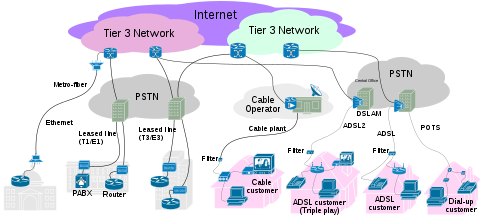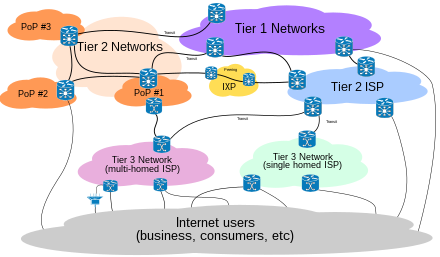Internet service provider
"ISP" redirects here. For other uses, see ISP (disambiguation).
| | This article needs additional citations for verification. Please help improve this article by adding citations to reliable sources. Unsourced material may be challenged and removed. (June 2007) |
Contents |
[edit] History
The internet started off as a closed network between government research laboratories and relevant parts of universities. It became popular and then universities and colleges started giving more of their members access to it. As a result, commercial Internet Service Providers occurred to provide access for mainly those who missed their university accounts. In 1990, Brookline, Massachusetts-based The World became the first commercial ISP (see http://www.zakon.org/robert/internet/timeline/, also published as RFC 2235 http://tools.ietf.org/html/rfc2235).[edit] Access ISPs
Main article: Internet access
ISPs employ a range of technologies to enable consumers to connect to their network.For users and small businesses, traditional options include: dial-up, DSL (typically Asymmetric Digital Subscriber Line, ADSL), broadband wireless, cable modem, fiber to the premises (FTTH), and Integrated Services Digital Network (ISDN) (typically basic rate interface). For customers with more demanding requirements, such as medium-to-large businesses, or other ISPs, DSL (often Single-Pair High-speed Digital Subscriber Line or ADSL), Ethernet, Metropolythian Ethernet, Gigabit Ethernet, Frame Relay, ISDN (B.R.I. or P.R.I.), ATM (Asynchronous Transfer Mode) and upload satellite Internet access. Sync-optical cabling (SONET) are more likely to be used.[citation needed]
- Typical home user connectivity
- Business-type connection:
[edit] Locality
When using a dial-up or ISDN connection method, the ISP cannot determine the caller's physical location to more detail than using the number transmitted using an appropriate form of Caller ID; it is entirely possible to e.g. connect to an ISP located in Mexico from the USA. Other means of connection such as cable or DSL require a fixed registered connection node, usually associated at the ISP with a physical address.[edit] Hosting ISPs
Hosting ISPs routinely provide email, FTP, and web-hosting services. Other services include virtual machines, clouds, or entire physical servers where customers can run their own custom software.[edit] Transit ISPs
Just as their customers pay them for Internet access, ISPs themselves pay upstream ISPs for Internet access. An upstream ISP usually has a larger network than the contracting ISP and/or is able to provide the contracting ISP with access to parts of the Internet the contracting ISP by itself has no access to.In the simplest case, a single connection is established to an upstream ISP and is used to transmit data to or from areas of the Internet beyond the home network; this mode of interconnection is often cascaded multiple times until reaching a Tier 1 carrier. In reality, the situation is often more complex. ISPs with more than one point of presence (PoP) may have separate connections to an upstream ISP at multiple PoPs, or they may be customers of multiple upstream ISPs and may have connections to each one of them at one or more point of presence.
[edit] Peering
Main article: Peering
ISPs may engage in peering, where multiple ISPs interconnect at peering points or Internet exchange points (IXs), allowing routing of data between each network, without charging one another for the data transmitted—data that would otherwise have passed through a third upstream ISP, incurring charges from the upstream ISP.ISPs requiring no upstream and having only customers (end customers and/or peer ISPs) are called Tier 1 ISPs.
Network hardware, software and specifications, as well as the expertise of network management personnel are important in ensuring that data follows the most efficient route, and upstream connections work reliably. A tradeoff between cost and efficiency is possible.
[edit] Derivatives
The following are not a different type of the above ISPs, rather they are derivatives of the 3 core ISP types. A VISP is reselling either access or hosting services. Free ISPs are similar, but they just have a different revenue model.[edit] Virtual ISP
Main article: Virtual ISP
A Virtual ISP (VISP) is an operation which purchases services from another ISP (sometimes called a "wholesale ISP" in this context)[3] which allow the VISP's customers to access the Internet using services and infrastructure owned and operated by the wholesale ISP.[edit] Free ISP
Free ISPs are Internet Service Providers (ISPs) which provide service free of charge. Many free ISPs display advertisements while the user is connected; like commercial television, in a sense they are selling the users' attention to the advertiser. Other free ISPs, often called freenets, are run on a nonprofit basis, usually with volunteer staff.[edit] Related services
[edit] See also
- Federation of Internet Solution Providers of the Americas (FISPA)
- Free-net
- IP address
- Internet backbone
- Internet Provider Security
- Network access point
- Second-level ISP
- Wireless internet service provider
[edit] References
- ^ thefoa.org/tech/fo-or-cu.htm - The Fiber Optic Association Copper and Fiber as data medium
- ^ cisco.com Sample Configuration for BGP with Two Different Service Providers (Multihoming) BGP article
- ^ Amazing.com "Hooking up to the Internet"


Tidak ada komentar:
Posting Komentar